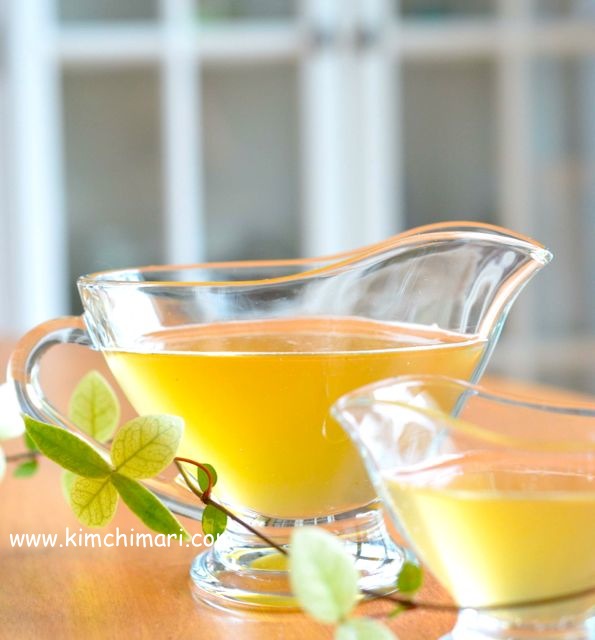
Korean Plum Extract – 매실 엑기스(Maesil Aekgiss) or 매실청 (Maseil Chung) or Green Plum Syrup – has only appeared in Korean cooking in recent years while Korean green plums (매실 Maesil, also: Chinese plum or Japanese ume) have been around for a long time. Records of its medicinal purposes go far back as 200 AD. But If you watch any Korean cooking shows or look up recipes on the internet these days, the syrup is used just about everywhere. In fact, it’s used a little too much in my opinion but that’s just me.. 🙂
The two terms, Aekgiss (엑기스) and Cheong (청) are used interchangeably to describe green plum extract or syrup. The word “Aekiss” comes from Japanese and it was their take on the word “extract”. Don’t ask me how you get “aekiss” from “extract”.. 🙂 On a side note, it IS amazing how languages change in different cultures..I’m constantly reminded not to pronounce English words correctly in Korea because people never understand what I say. For example, if I say “Food” almost no one will understand whereas if I say “Pood”.. then everyone knows it!
The word Cheong actually means a type of syrup that’s made by either physically or chemically changing certain grains without any added sugar. For example, Brown Rice Syrup (called 조청 Cho Cheong) is made from culturing cooked rice with enzymes with no additional sugar. So if you think about it, neither of these terms are fully accurate..
While I was living in the US, I resisted using this Korean plum extract in my recipes. It’s not something I grew up eating and therefore I did not feel it was authentic. Also, the Maesil Cheong is not a very readily available ingredient for many people outside of Korea, so I hesitated using them in my Kimchimari recipes. BTW, if you can’t get any plum syrup, no worries, just use plain ol’ sugar or rice syrup instead.
Now that I’m living in Korea, I’m finding that I just can not ignore Maesil Cheong anymore. It is such an integral part of Korean cooking that both my mother and mother-in-law (who is usually very traditional) now make maesil chung every year! In addition to being a great fragrant sweetener in cooking, Maesil also has many health benefits. Probably why it’s become so popular in Korea because Koreans just LOVE anything that is known to be healthy.
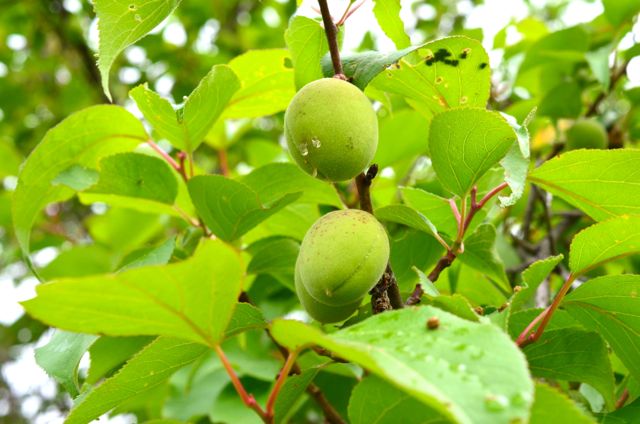
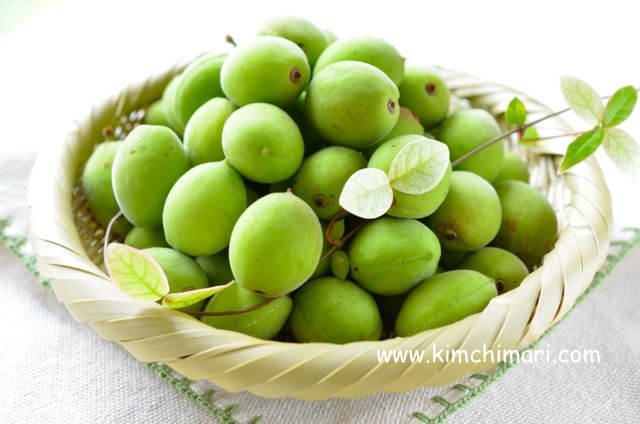
This May, I found these wonderful plum trees in our farm and after having tried it for a year, I just could not pass up the chance to make the maesil cheong green plum extract syrup myself!
How to use Korean Plum Extract or Maesil Cheong
Before we talk about how to make Korean Plum extract (Maesil Cheong), I want to share how I use it in my own home.
- Make hot or cold maesil drink – from my personal experience. drinking plum syrup + water definitely helps with indigestion especially after a large meal so it’s definitely a great dessert drink. You can serve it cold or hot, both taste and feels great. One thing though, if you have an acidic stomach, you might want to be a bit careful.
- I use Maesil Cheong in addition to sugar in many dishes – because Korean green plum extract is sour and sweet, I don’t substitute sugar fully but I substitute a little sugar with maesil or just add a splash in addition. It usually enhances the flavor of any dish when you add just a splash. Here are some dishes I always add to (I just don’t usually have it listed in many of my recipes because I didn’t want to make everyone to buy it or use it).
- Bulgogi or Kalbi marinade
- Kimchi – even though I don’t say it in each recipe, I often add a splash in all my kimchi when I make it. It’s totally fine without it but it does add that little extra something when you do.
- Fish Jorims – wow somehow I don’t have a recipe up for this but if you do make any, you can add a swirl
- Salads – like Lettuce Salad or Cucumber Salad
- Chogochujang Sauce
Ingredients
** 2 lbs of plums produce about 1 quart of syrup
- 2 lbs Green Plums
- 2 lbs sugar (white or organic unbleached)~ 2.4 lbs sugar
- 1 glass jar or breathable earthen ware (항아리 Haangari) large enough to hold both sugar and plum
Directions
- Wash the plums and drain. Let the plums completely dry by leaving it for few hours in a colander or better yet, spread them out onto a baking pan or tray lined with paper towel.
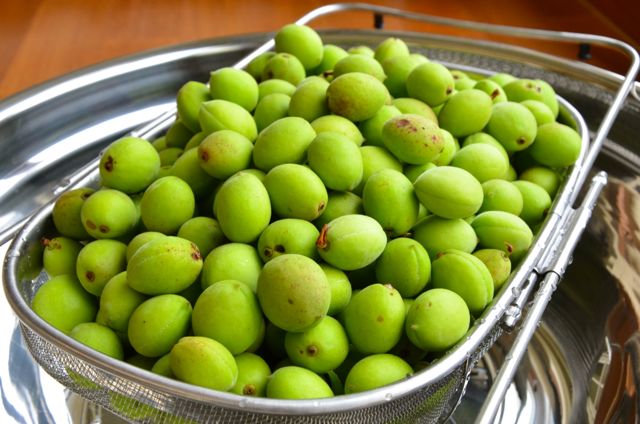
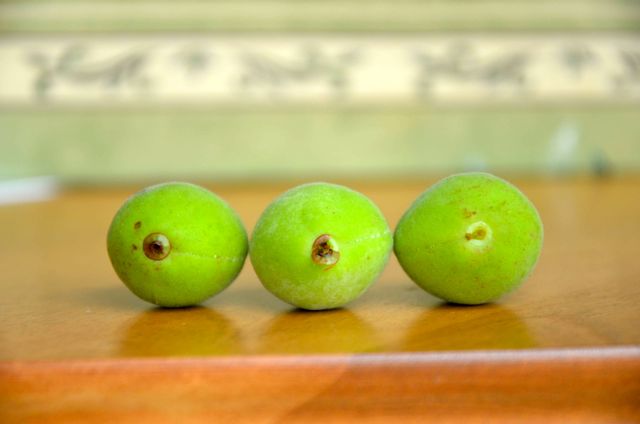
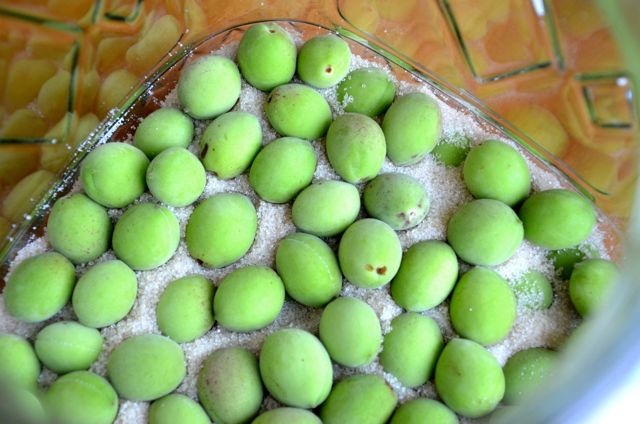
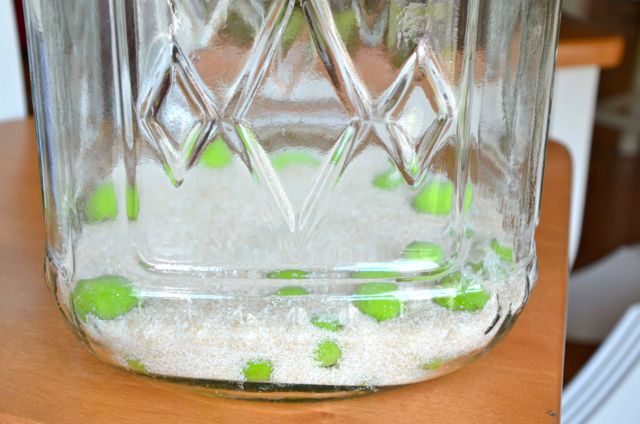
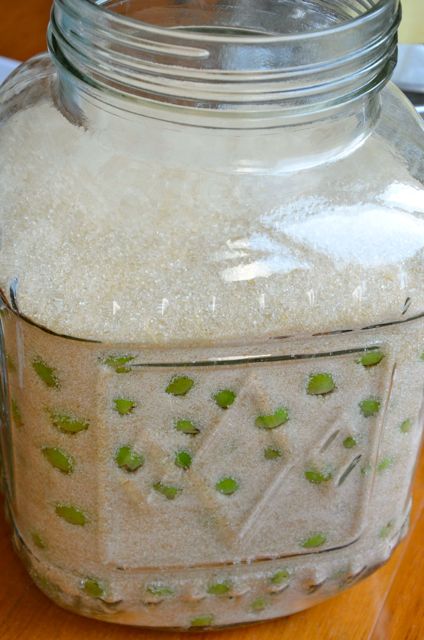
And that’s it! Cover the jar and leave it in a cool place for 90 days and the syrup should be ready.
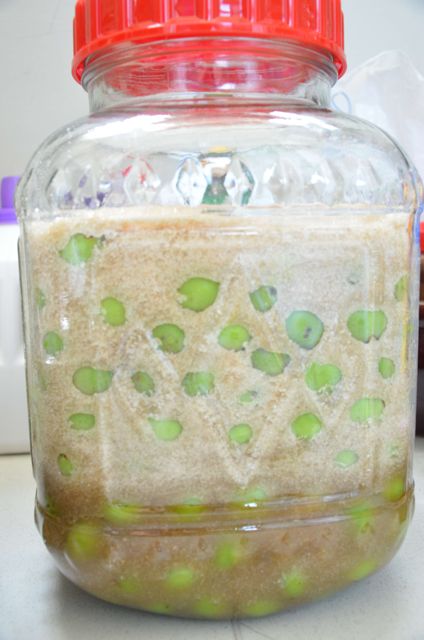
BUT WAIT!!! A bit more work is still needed..many (including me) have failed because they did not stir the syrup afterwards. See below – notice how the sugar has accumulated at the bottom of the jar. You need to stir the green plum syrup every 2 days or so (prob. for about 7-10 days) until the sugar is fully dissolved in the plum juice. You should still stir the plum syrup every now and then for the remaining 80 days. Stir if you see the top plums take on a different color or if you see white stuff appearing on top.

After 90 days, remove the plums with the seeds – which now will have no flesh left and look all shriveled up. Store in jars at room temperature and it will keep for at least a year or more.
Maesil Syrup Substitute
If you can’t find Korean plum extract maesil syrup, just mix 1 Tbsp water + 1 tsp apple cider vinegar + 1/2 tsp sugar to substitute 4 tsp Maesil Syrup!
In addition, consider the following:
- Don’t hold back on the SUGAR!!
- The key to making good Korean plum extract syrup is the ratio of plum to sugar. The basic is 1:1 but depending on how big and juicy the plums are, you may want to increase the ratio to 1:2. More sugar increases the success rate since more sugar means less chance for mold to develop or turn sour instead of sweet. A friend of mine used exact 1:1 ratio and failed on her first try. So I decided to increase the sugar amount to not quite 1:2 but something like 1:1.5..and SUCCESS!!
- · What sugar to use? Brown vs White vs Organic?
- This is quite a dilemma…Using white sugar will intensify the plum fragrance in the syrup but we all know it’s not the best thing for your health. I used organic unbleached sugar here. Brown sugar contains molasses like substance in addition to sugar which can diminish the flavor and fragrance of the green plums.
History of Korean plums: The oldest record of these little plums is in Chinese medicine. Chinese smoked these on top of a fire and used it to relieve pain and also take care of intestinal problems. Japanese used Ume Boshi to prevent rice from going bad in the summer.
In the last few years, studies have shown the following:
- The large amount of citric acid in the plums help the body get rid of lactic acid therefore helping the body recover faster
- The acidic plums help with secretion of saliva and digestive enzymes aiding with digestion
- The plum syrup kills off harmful bacteria to help with diarrhea and promote normal bowel function


Lastly, here are some pictures to show you how the plums look after 30 days (top left) and after 100 days (top right). As you can see the plums will turn brown after 30 days or so and that’s ok! Just drain and discard the browned, shriveled plums after the 100 days.
Enjoy!
Maesil Cheong (Green Plum Syrup)
Ingredients
- 2 lbs Green Plums
- 2 lbs sugar (white or organic unbleached)~ 2.4 lbs sugar
- 1 glass jar or breathable earthen ware (항아리 Haangari) large enough to hold both sugar and plums
Instructions
- Wash plums and drain. Let plums completely dry.
- Remove any stems including the little stub near the stem. Removing the stub is not a must but if you don’t, stubs will later float around in the syrup and you will have to strain it to get rid of it.
- Discard any plums that are rotten because these can spoil the syrup.
- Sanitize the glass jar by rinsing it with boiling water or alcohol.
- Layer sugar and plums alternately in the jar. This means you need to divide the sugar and the plums equally so that you don’t run out of sugar at the end. If you layer the sugar so that it just about covers the layer of plums, it should work out OK.
- Cover the jar and leave it in a cool place for 90 days.
- After 90 days, remove the plums with the seeds and store the syrup for use. Can be stored at room temperature for many months, even a year or more.
Tips & Notes:
- Don’t hold back on the SUGAR! The key to making good plum syrup is the ratio of plum to sugar. The basic is 1:1 but depending on how big and juicy the plums are, you may want to increase the ratio to 1:2. More sugar increases the success rate since more sugar means less chance for mold to develop or turn sour instead of sweet.
- What sugar to use? Brown vs White vs Organic? This is quite a dilemma…Using white sugar will intensify the plum fragrance in the syrup but we all know it’s not the best thing for your health. I used organic unbleached sugar here. Brown sugar contains molasses like substance in addition to sugar which can diminish the flavor and fragrance of the green plums.
- You need to stir the syrup every 2 days or so (prob. for about 7-10 days) until the sugar is fully dissolved in the plum juice. You should still stir the plum syrup every now and then for the remaining 80 days. Stir if you see the top plums take on a different color or if you see white stuff appearing on top.
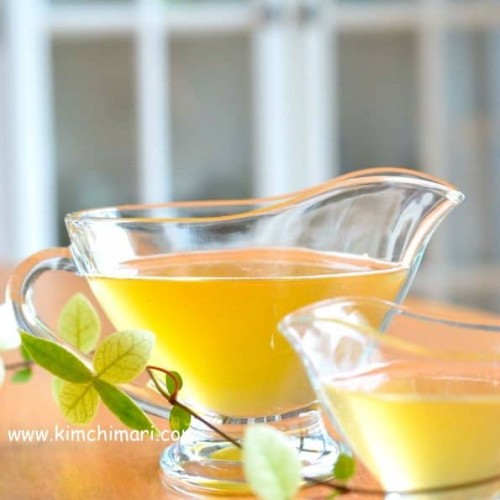
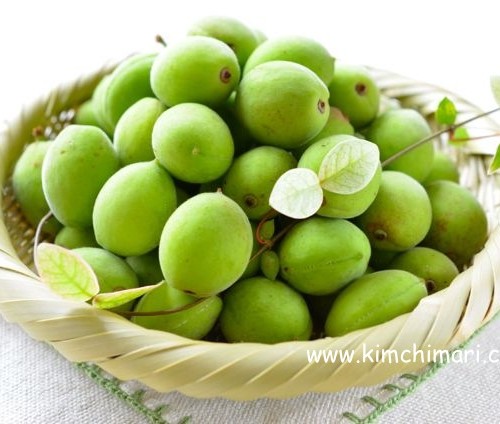

















Hello,
How do you know if the syrup has gone bad? Will there be a certain smell or color or mold? I made two batches, and one smells nice and sweet, and the other smells differently, and seems to be developing some kind of waxy, white residue on the surface…
And what exactly do you mean by stir? Ive been sterilizing a utensil then stirring the syrup with it… is that okay?
Thanks for reading!!
Yes, it should smell nice. Sometimes if there is not enough sugar or if the plums were not cleaned and dried (after washing) properly, you can get a thin layer of white film on the surface. You can just discard the white film as much as you can and then stir often for few days and then it should not appear again. Also, sprinkling the top with some extra sugar can help. Yes, stirring just means to stir everything so all the plums stay coated fully with the sugar liquid. It is the sugar that stops mold from developing so it’s good to keep everyone coated. I never sterilized my utensil – it should be fine to use just clean spoons. Hope this helps. Let me know if you have more questions. Good luck!
Thank you so much for checking. I will definitely look up ‘Amygdalin’ and see if there’s other reports written on the subject. For now, I just separated the plum from juice on all the 4 month old jars. Seems like a waste to through away the plums. I fill the jars with drinking water hoping I’ll be able to get a little more flavor from the plums. Tomorrow I’ll drain the water from the plum and save them.
Thank you again…I learned so much today! I also subscribed to your site. Hopefully I’ll be able to successfully make one of your recipes…
Hi there! I’m at about 75 days now and there is still sugar at the bottom. I didn’t stir as often as you mentioned because my mom makes it every year and she doesn’t stir so much (this is the 1st year I’m making it instead of her). Should I just stir more often for the remaining 15 days? Should I stir more AND let it feement longer than 90 days? When my mom makes it, the resulting syrup is thick like maple syrup but when I do stir, it’s still pretty liquid-y. Thanks so much for your help!
Hi! Hmm.. maybe your mom used more sugar? There’s a recipe that uses more sugar than just 1:1 and that could also explain why it was thicker? Yes, you should stir often for the remaining 15 days to make sure all the sugar gets dissolved. I don’t think you should ferment longer than 90 days. And the consistency is more liquidy than maple syrup so what you have now sounds pretty normal.
Stirring also makes sure you don’t end up with fungi on top so I would say stir as often as you can.
Good luck!
I have a question! Why 90 days? What happens if I kept it for a year? My Korean friend taught me to make this and I have consumed several jars but there’s one big one that was made since May 2014. Is it bad to consume it? I made more this year at May 2015. So it’s been 4 months. Should I hurry and take it quickly? I’m concern if there’s any problem if I kept them longer than 90 days! ?
Hi!! Oh so 90 days is when you should take out the plums because there is some slightly poisonous stuff from the seeds that can come out. Just is the case with many seeds.
90 days is when it fully matures. You can certainly consume it for many months after and I actually am using maesil syrup I made last year! So as long as it taste ok it should be fine. Thanks for asking!
Wow, thank for your quick response.
So is it okay to use the jar from last year? The plums are all inside with the juice. I can separate them quickly, or is it too late? Don’t drink it? What about the 4 month old, is it dangerous to drink that also?
I have done some research and I have certainly read many Koreans saying they have consumed plum syrup with plums being in it for like a year and they were all fine. However, that’s just people saying it. Unfortunately I really don’t know enough about it to tell you what to do. Some say the reason for taking the plums out is not because of the toxin but because the flesh starts to disintegrate after that. I personally have not tried it so I just don’t know. The toxin that comes out from green plum is called Amygdalin. Some say sugar breaks that down or some say heating the syrup or letting it ferment for longer periods will make it OK. But because I have not found any substantial research results on it, I am not sure. I assume 4 months is probably OK because some say 90 days, some say 100 days. And 4 months is just 20 days over. I also saw several Japanese Plum wine (Umeshu) recipes and they say it’s OK to leave the fruit in alcohol up to 1 year so that kind of tells me it’s probably OK. But I think you should research about Amygdalin and green plum and decide for yourself. Sorry I can’t be of more help. Good luck!
Oh, so, now that I think about it, I think I have certainly made and consumed plum syrups with plums in them for like 100 days and that was totally fine.
Hi!
Should I really need to wait up until 90 days to enjoy the syrup? Now I’m at day 10th and the whole sugar has already dissolve completely..
Thank you in advance for the answer…
Yes. Because the syrup actually needs to ferment and at the end of 90 days the juice of the plum will be all extracted into the syrup. Right now its nothing more than just simple sugar syrup. Be sure to stir often to avoid the top area from becoming moldy. Be patient and u will have a wonderfully sweet and sour fermented syrup that u can use in your cooking!! Thanks for asking!
Hi, Jin Joo, I was wondering if the sugar has to be in dry form, or if I can use agave syrup. I bought 1/2 lb of the plums, and was curious if anyone has tried it with the agave.
Hmm.. honestly I don’t know if that will work. Sugar is in dry form so it draws the moisture out from the plums but not sure what will happen if you used agave. I also wonder if the fragrance will not be as strong…Great idea though – would love to hear back if it works out for you or not.
Thank you for this post. How do you strain it once the fermentation is done? Also, when you say your friend only used 1:1 maesil to sugar and it failed, what happened? I’m making my first batch ever and using a large jar and I’m nervous it’s not going to work after so much money and time. Thank you!!
Hi! You can just use a colander to strain it since the maesil fruits will all stay intact. When there is not enough sugar it can become kind of like maesil wine/vinegar. Don’t worry – just make sure you stir often to keep any fungus or foam forming on top. You can also add more sugar later if it looks suspicious. Good luck and you are very welcome!